Quote about Moe would think they meant 13 fairways and have read his stroke average was 69.8. Either way he was not hitting the ball everywhere with 5 wins, 5 seconds. Lag could second that, he was lucky enought to play and hit with the legend.
A bit off topic, but in reply to RR’s Hogan Truck photo- there was a story yesterday about a sports car flying off the road and into a house, here’s the photo. Not sure how it happened, and it’s possible there were people hurt, but I thought the idea of modern fast cars with max speed and no mass flying out of control and being destroyed by a solid structure was too good an analogy to resist… This picture vs. the thought of the Hogan Truck hitting the same structure is a great contrast…
I remember drawing an analogy on here between a Ferrari and a Cement Truck hitting a wall, and which one you’d prefer to be driving… this fits well with that picture…
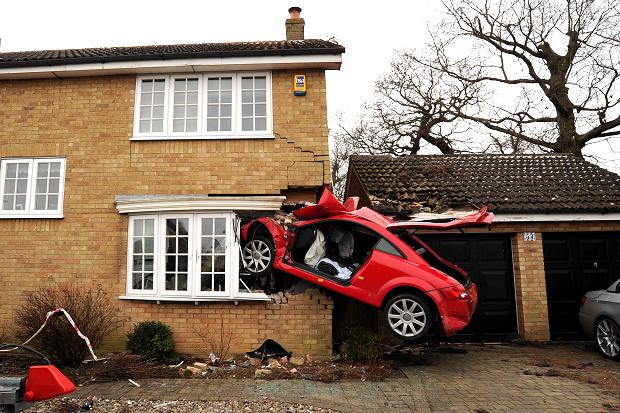
Yikes…even for thrill seekers.
I wonder if once airborne the driver instinctually attempted to turn the steering wheel in a lame effort of avoiding-controlling impact and finding that without ground contact the car was cooked. ![]()
Bom and Rat, this goes with Peter Senior from the bunker as my favorite module 2 visual.
Hogan truck had more mass, 18 wheels on the ground instead of 4. Like Hogan himself, the truck would have moved the whole wall.
But, once we’re golfing, what is it about pure speed that makes it so tempting? The first logical thing is… Faster clubhead hits the ball farther, right? Swing faster! But that’s really denying the nature and quality of the impact. That super-speed (for me at least) comes directly from sacrificing structure, connection and the ‘heaviness’ of true solid contact.
Bom I remember you writing somewhere about sensing different body parts moving at different speeds (hips v. shoulders. v. hands), and how certain combinations worked great, and others you associated with spraying it everywhere. I think that was getting at this same issue. We need both speed and strength, but we need each to come from the proper sources. It’s when the jobs get scrambled that everything goes haywire. So: Which intention really gives us the correct sensation? What feels and imagery can keep the slow things slow while letting the fast things be fast?
My golf game gets better and better the more I focus on a ‘cement-truck’ intent, the exact opposite of the ‘ferrari’ flash speed. Of course in this analogy the ‘mass’ part isn’t just be clubhead mass, but the functional mass added by holding the shaft flex with internal cohesion. Those times I feel like I’m hitting with my whole body: hands, forearms, shoulders, abs, hips, and legs, all rooted deep into the ground… Only then does that desire for pure speed start to subside. The best sensation is one where the speed of the swing never compromises the connection. So if I’m focused on being internally solid as the whole goal, it only goes as fast as it can, and no faster.
For me personally, the concept I need to keep hammering into my head has to do with: Flash speed=disconnection=hit and hope. STOP IT!!! I want to be as fast as I can be while retaining ‘solidity’. Any speed at the expense of structure is worthless. It’s a real mental hurdle…

[youtube]http://www.youtube.com/watch?v=2-la-PTbFoc[/youtube]
[youtube]http://www.youtube.com/watch?v=tMxacWHq1nQ[/youtube]
Nice video work Chris, on the double image.
I’ve been ponderin’ the following image intention wise as to me it feels and fits like Lag’s Hogan Vimeo of Mod 3, going straight upward from lowpoint.
Given the zone arc we’re moving in, with racing there is an corner apex and depending how one enters the curve goes a long way in determing how one exits the curve. The apexes- being defined as the closest point to the curb- are either early, centered, or late, and the late apex gives the best way to enter the curve so that maximum speed is reached more quickly after the curve, or lowpoint.
The early apex ( which would be hands to close to us too early ) throws the car too far out to the right, so too much slowing down is needed to get back on track. A centered apex is the normal I guess but takes longer to get to full acceleration than the late apex. That’s maybe why the short hand/arm travel but with full turn going back is cool. It will keep the hands wider initially, more outside feeling once lowered onto the track.
Now the late apex burns my britches but good. Not only is it the safest, but allows one to fully jump on the accelerator faster than any other apex point because we are closest to the curb late…or the hands are closest to our body late…and then full tilt boogie from there. If you follow the late line in relationship to the curve, it seems, and feels like to me, the driver is OTT of the curve prior to lowpoint, and exits stage left hard, and straight up the track…because the late line starts accelerating at the correct apex point.
Just thought it was interesting looking not only at flight apex, but ground apex as well. It’s spring…gentlemen start your engines. ![]()
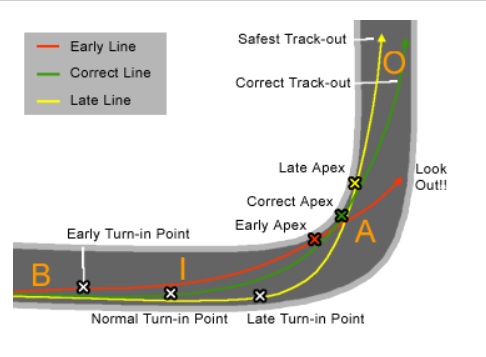
The track cornering is a very good analogy. Thanks for posting.
Tight forearm rotation verses the dead hand sweep.
In the Hogan montage, it’s interesting to note how Hogan’s head really lifts upward through impact. This is caused by the level shoulder rotation. It needs to do this, but can be tamed some by keeping flex into the left knee longer. If the torso rotation can accommodate a substantial range of motion … then all the better.
So yes…
Start your engines and whip it around the track.
Just thought it was interesting looking not only at flight apex, but ground apex as well. It’s spring…gentlemen start your engines. ![]()
[attachment=0]1line.jpg[/attachment]
[/quote]
Nice diagram, Double R, very interesting. That Rat brain of yours sure likes to think through things… Thanks for sharing…
B
Great article, shows some of the genius of Hogan.
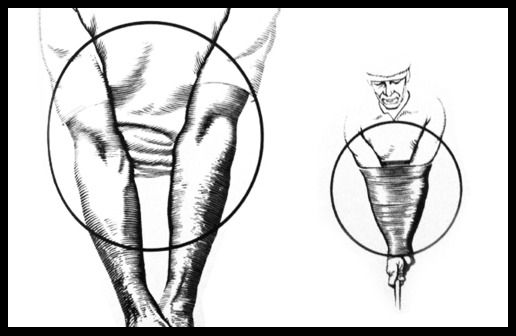
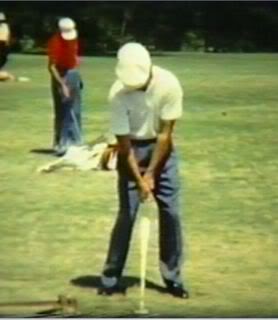
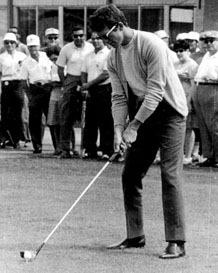
It is clearly obvious that Hogan and his understudy Knudson did not squeeze thier arms together like the iconic five lessons image. Most modern day players have thier arms much closer together than the old school golfers. I have been thinking of the pro’s and cons of having your arms close together or bent apart. I was hoping to get everyones thoughts and feedback and any experimentation regarding this topic.
My initial thoughts were this setup is based on body structure and arm length but then the knudson photograph clearly tells me that he purposefully bows his arms out. This setup may be why Knudson had the toe on the golf ball at address.
Agree re: Hogan’s book vs. Hogan real. Knudson is a unique case in that he lined the ball up on the toe of the club so it doesn’t surprise me to see slack in the arms at address and straight arms at impact.
I think Hogan’s depiction of the “Roped arms” is mainly a showcase of how swinging a heavy mass will effect one’s levers. Knudson kept his arms(and his entire body for that matter imo) relaxed and addressed the ball on the toe. Hogan would line up on the toe of his clubs, but would use a slight “stretch” before beginning his takeaway. Norman addressed the ball back and on an inside (4:30) line with his front lever stretched and his right elbow tucked slightly.
The levers they establish are different between all the great strikers, but Hogan really is truly a genius… "The most important part of the swing to me is the “Start of the downswing.”
Norman - “Buckle, Sit, Slide, Bump.”
Knudson - “Proper transfer of weight.”
I think if you can find the proper sequence of events into and through the “business area”, it provides you with those ground pressures to leverage some arrows out there.
Hogan was a Time Lord. Note the smart phone in his right front pocket. (Keep this on the down-low. You didn’t hear it from me)
We all know that Hogan said he wished he had three right hands! I was wondering if that means that his dominate hand was his right hand?
this reminds me often times seing Vjay as a swinger having his right hand coming off the club after impact, which tells me that swingers should have the left hand dominate and hitters be right hand dominate. Any thoughts would be appreciated!
Anyone correct me if I am wrong, I feel the hands work together with both being dominant at different points. I have not seen a hitter with a popeye forearm, always popeye forearms. These are built from tension holding the club through the swing, especially built when fighting the force of the club being pulled away from the body as you rotate. Three right hands is because of where he was hitting from, right hip pocket to left hip pocket. The handle of the club has to be working left, I try to feel that it is right by my left pocket and in front of my hip from caddy view when the club is coming into impact. Think module 3 starting position, move the clubhead while in that position to before impact using forearm rotation. You should feel your right elbow and arm become tight against your body and the clubface will be open, now fire your right hand while keeping the right arm pinned. Players will see where most are confused about the right hand. If you do a wrist slap from that postion it does not square the clubface, must be forearm rotation.
[youtube]http://www.youtube.com/watch?v=PNOvmGN5NWk[/youtube]
New video from Two. This video is not about Hogan, but it shows how he was nearer to perfection than anyone else in the shortest explanation that I have ever heard.
I cleaned my basement - and I still have the pictures which I cutted out from the Golf Digest Magazine:
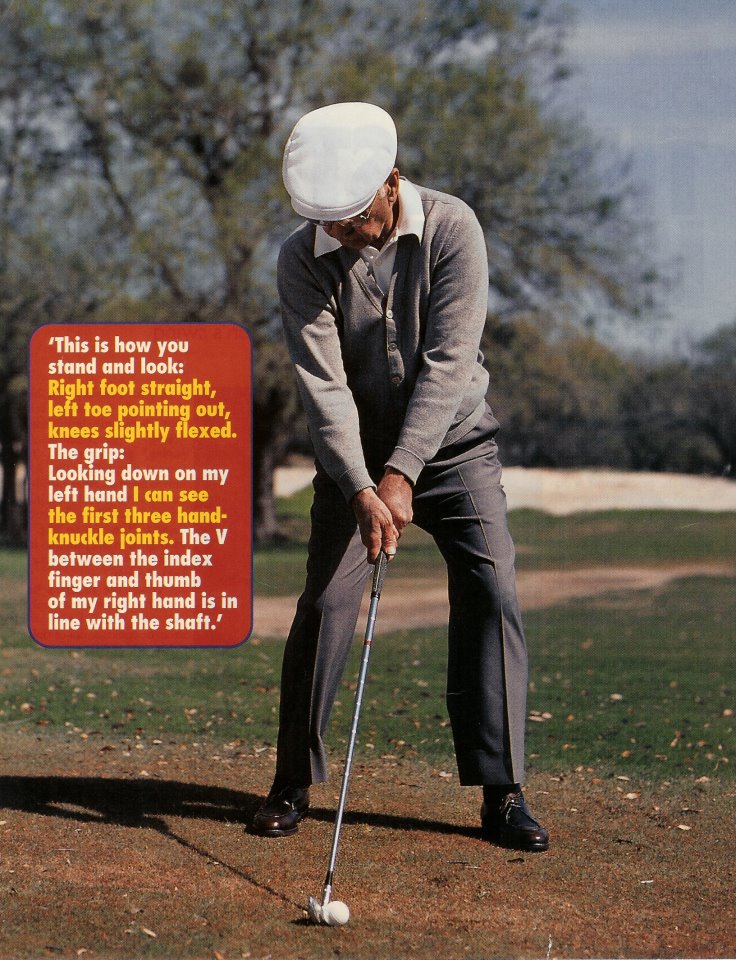
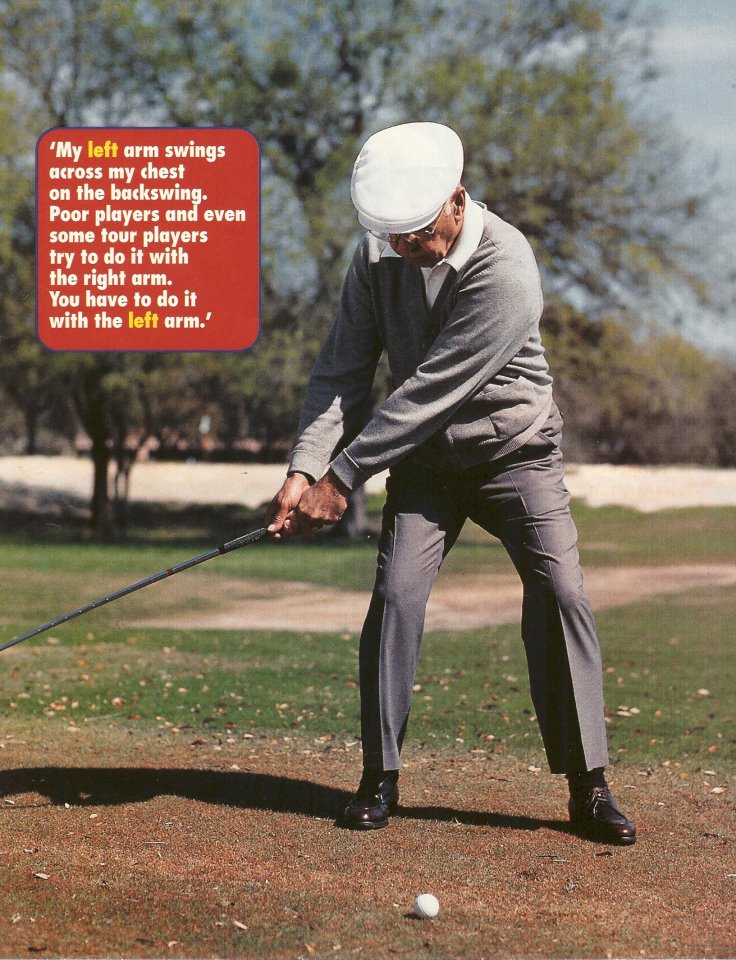
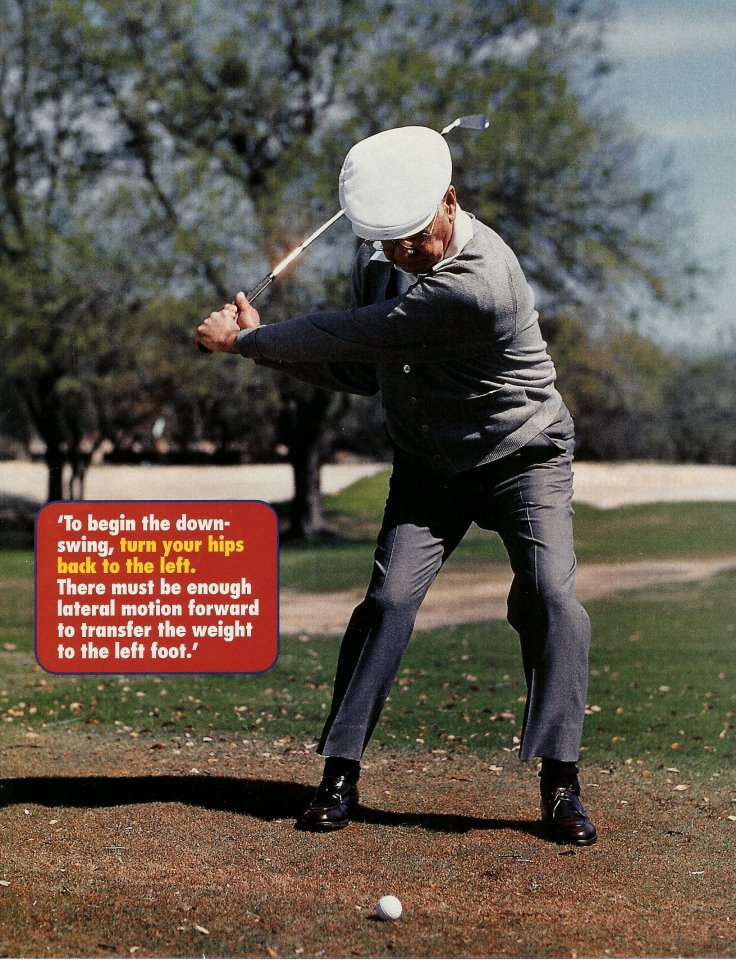
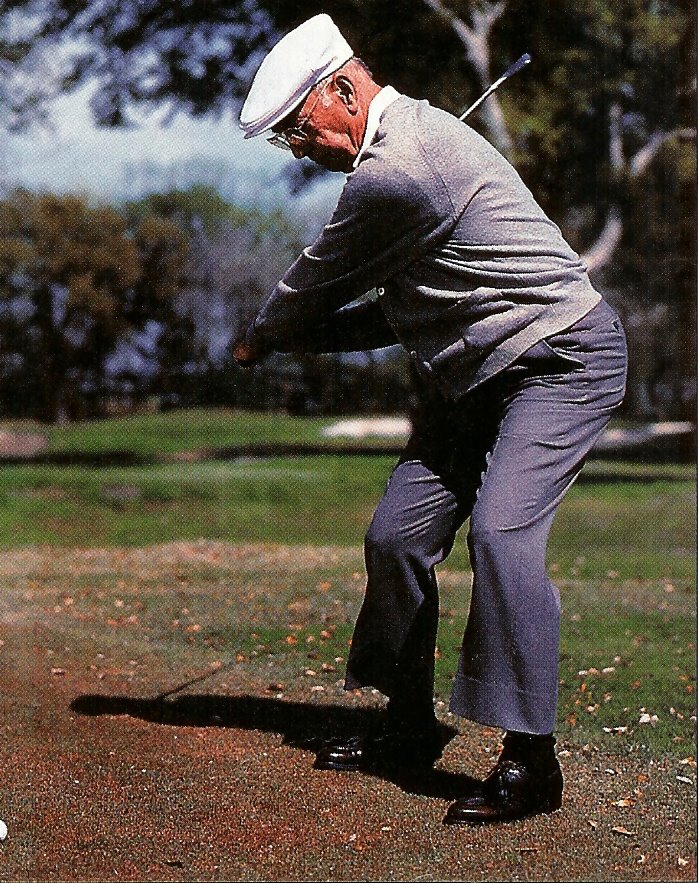
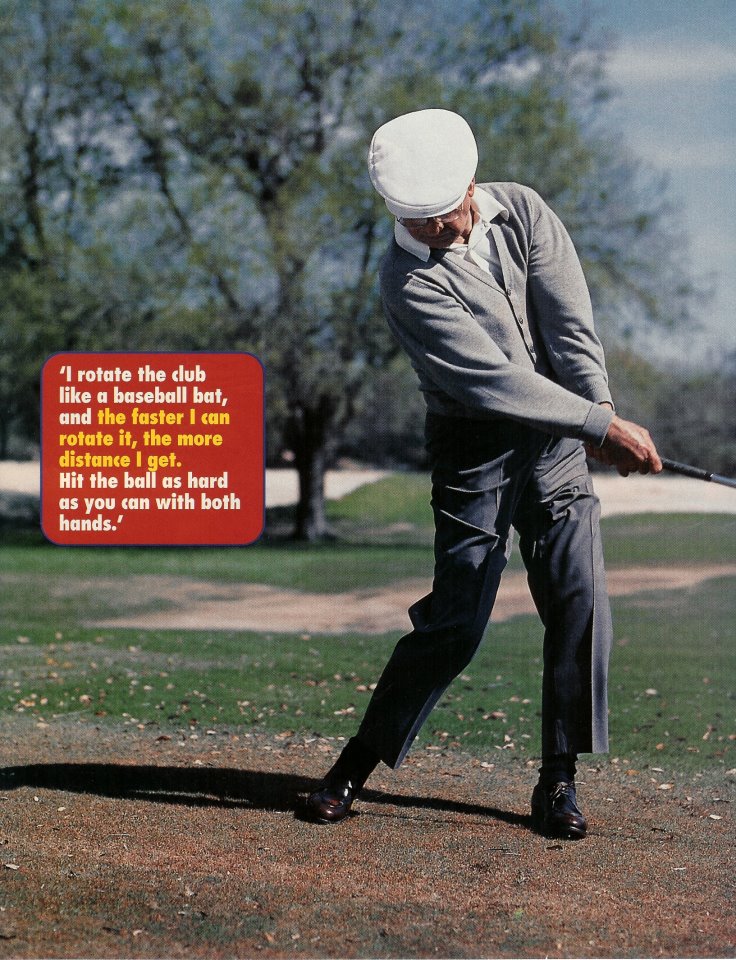
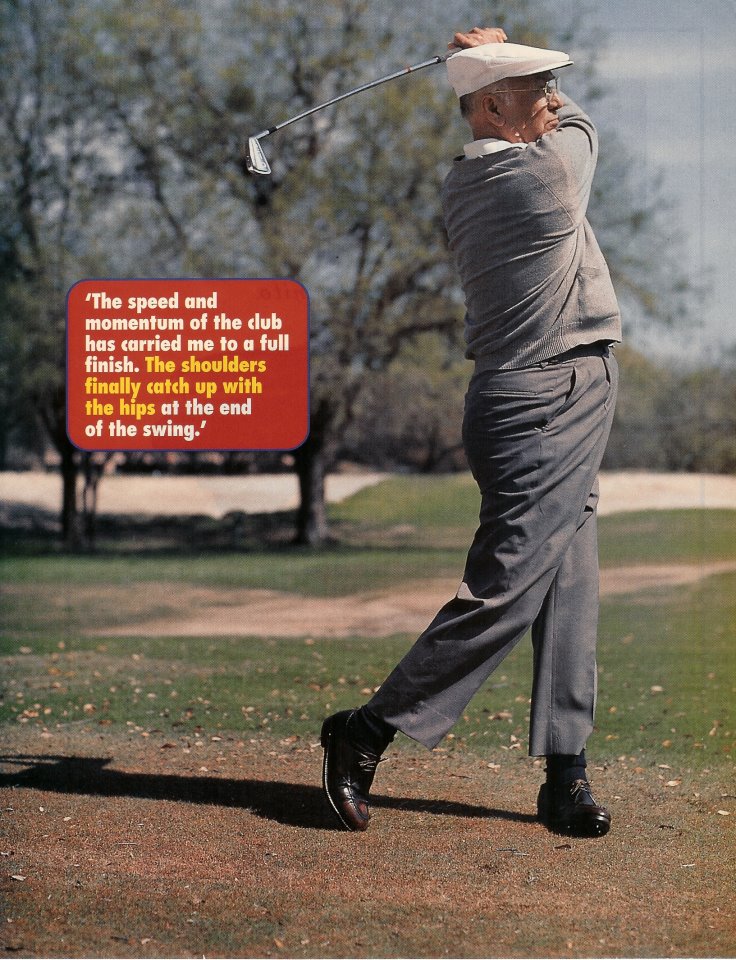
I still love them…
Chris

I’d bet Ben made sure that final picture showed the latest Apex ll Cameo release from the Hogan company. Subliminal advertising peaked in the late 70’s. ![]()
That was the first “real” set of clubs I got that someone put under the Christmas tree. Dad maybe? Was out at the golf course Christmas morning and played those irons all through junior golf and 4 years of collegiate golf. Won a lot of events with that set of Apex ll.